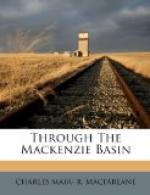It was indeed a gala time for the happy-go-lucky Lakers, and the effects of the issue and sale of scrip certificates were soon manifest in our neighbourhood. The traders’ booths were thronged with purchasers, also the refreshment tents where cigars and ginger ale were sold; and, in tepees improvised from aspen saplings, the sporting element passed the night at some interesting but easy way of losing money, illuminating their game with guttering candles, minus candlesticks, and presenting a picture worthy of an impressionist’s pencil.
But the two dancing floors were the chief attraction. These also had been walled and roofed with leafy saplings, their fronts open to the air, and, thronged as they generally were, well repaid a visit. Here the comely brunettes, in moccasins or slippers, their luxuriant hair falling in a braided queue behind their backs, served not only as tireless partners, but as foils to the young men, who were one and all consummate masters of step-dancing, an art which, I am glad to say, was still in vogue in these remote parts. “French-fours” and the immortal “Red River Jig” were repeated again and again, and, though a tall and handsome young half-breed, who had learned in Edmonton, probably, the airs and graces of the polite world, introduced cotillions and gave “the calls” with vigorous precision, yet his efforts were not thoroughly successful. Snarls arose, and knots and confusion, which he did his best to undo. But it was evident that the hearts of the dancers were not in it. No sooner was the fiddler heard lowering his strings for the time-honoured “Jig” than eyes brightened, and feet began to beat the floor, including, of course, those of the fiddler himself, who put his whole soul into that weird and wonderful melody, whose fantastic glee is so strangely blended with an indescribable master-note of sadness. The dance itself is nothing; it might as well be called a Rigadoon or a Sailor’s Hornpipe, so far as the steps go. The tune is everything; it is amongst the immortals. Who composed it? Did it come from Normandy, the ancestral home of so many French Canadians and of French Canadian song? Or did some lonely but inspired voyageur, on the banks of Red River, sighing for Detroit or Trois Rivieres—for the joys and sorrows of home—give birth to its mingled chords in the far, wild past?
As I looked on, many memories recurred to me of scenes like this in which I had myself taken part in bygone days—Eheu! fugaces—in old Red River and the Saskatchewan; and, with these in my heart, I retired to my tent, and gradually fell asleep to the monotonous sound of the familiar yet inexplicable air.
Chapter V
Resources Of Lesser Slave Lake Region.




